At DSEI 2025, BAE Systems presented its vision for the Royal Navy’s future surface fleet, including the long-term pathway towards what could become the Type 83 destroyer with a distributed system-of-systems approach built around a large Air Warfare Command Ship and smaller, highly adaptable combatants.
Speaking at a media briefing, Geoff Searle said BAE is modernising its combat management system under the long-term “Re-Code” contract awarded last year. “We’re now putting significant investment into the complete modernisation of our combat management system to develop into version two. This will be the foundation of the sovereign core desired capability,” he explained.
The new architecture, he added, would enable the Royal Navy to integrate partners, equipment and uncrewed systems through “assured, secure and agile interfaces.”
Neil Griffiths expanded on the themes shaping BAE’s naval design: technology leadership, sustainable energy management, mission technology, manufacturing innovation and lean crewing. “We are striving to drive cost, reduce time schedule and improve qualities on these key programs,” he said, citing advances in welding, robotics, and lightweight structures. Lean crewing, he noted, is central to increasing mass in the battlespace while reducing risk to personnel, with automation and autonomy integrated into new platforms.
Gavin Rudgley pointed to three drivers for the future fleet: evolving high-end threats, lifecycle adaptability, and reduced crewing. AI is already being used to accelerate ship design, he said, with hundreds of hull forms now modelled in hours rather than months.
“There is a drive across many navies to reduce the complement on naval ships. That’s going to come about through automation, autonomy and the embodiment of artificial intelligence, but also through a cultural change in the way ships are operated,” he noted.
Rudgley unveiled two concept designs. The first is a large Air Warfare Command Ship hosting sensors, missile batteries, naval guns and directed-energy weapons, alongside command functions for smaller deployed platforms. Survivability is a key consideration, as the vessel would act as a high-value node within a dispersed network.
Alongside it, a smaller trimaran combatant is envisioned as a deployable sensor-effector platform. The model displayed at DSEI, based on the Triton trimaran demonstrator hullform, included systems such as Artisan radar, a 40mm Mk4 gun, vertical launch cells, towed sonar array, Herne autonomous submarine integration, and lean crewing design. Ultra-lean manning, and potentially full autonomy, are under study.
When asked by UK Defence Journal whether Type 83 could be an evolution of the Type 26 design given the similarity between the design of the revealed concept and that of Type 26, BAE representatives confirmed that was one option under review. “Clearly, if we could do that, that benefits from saving in the development costs and timescales. Type 26 has proven to be a very capable platform with margins, so it’s an obvious thing to build on,” one official said.
The models displayed at DSEI highlighted the flexibility BAE intends to embed in its designs. The Air Warfare Command Ship concept included options for Mk41 vertical launch cells, 57mm and 40mm naval guns, LDEW, uncrewed systems such as the T650 UAV and UUVs, and a choice of 130m or 150m hull configurations. The smaller trimaran showed a containerised mission bay capable of embarking assets like the T-650 with Sting Ray torpedoes.
Together, the two designs illustrate how BAE Systems envisions a distributed fleet structure for the Royal Navy: a blend of powerful command ships and adaptable, lean-crewed or autonomous escorts, designed to evolve with threats and technologies over decades of service.


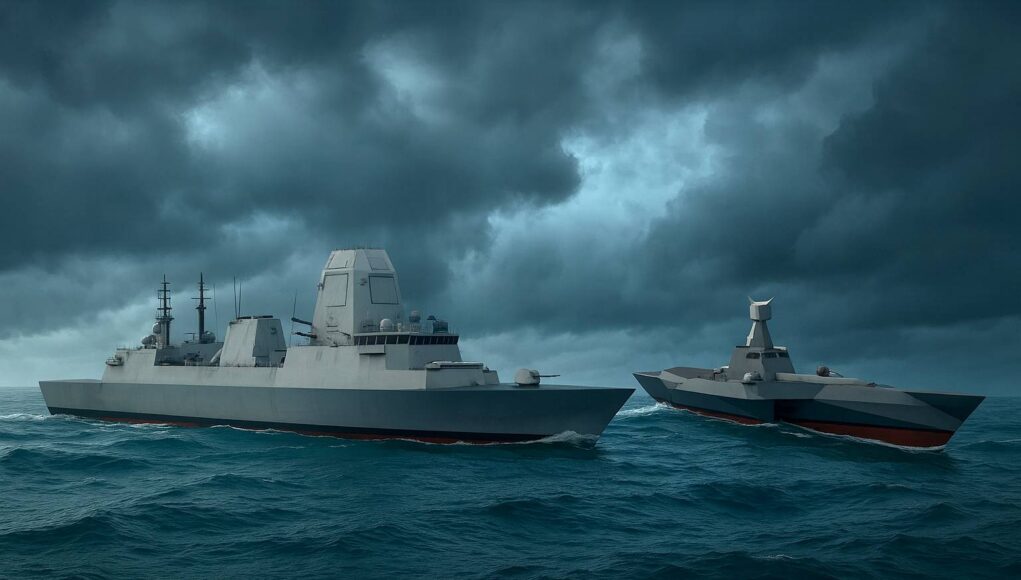


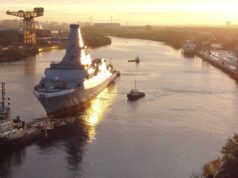
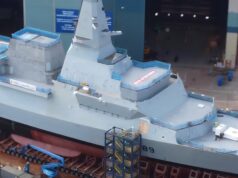

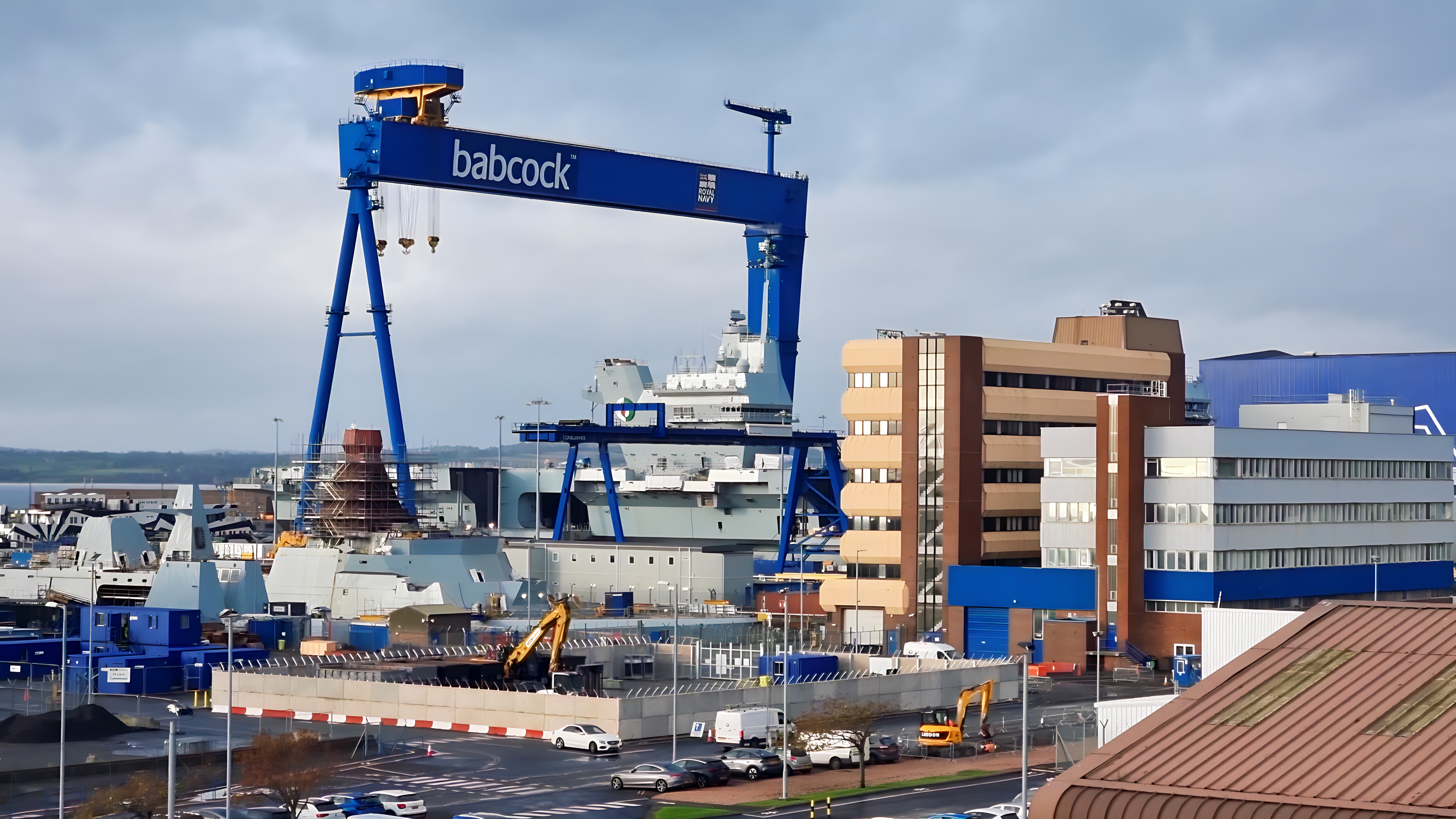

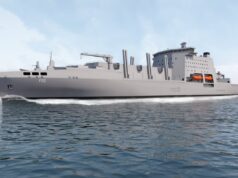

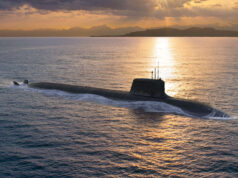
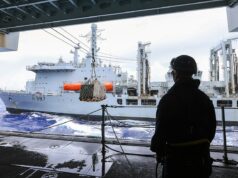
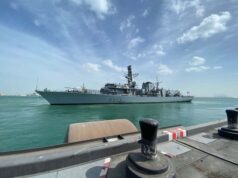

George, please could you take some more photos of the FAWCS models and concepts for us? For some reason it’s been one of the least well documented items at DSEI despite T83 being one of the largest programmes, and it would be nice to get a clearer idea of what the hard stats are about it.
Interesting that the displayed options were either smaller than or equal in length to the current Type 26 frigates. I’d really love to see some images.
Yes that throwaway thing about 130 or 150m is very strange. It’s always hard to scale warships by eye, but the ‘big radar’ concept we’ve been shown recently looks slightly bigger than T26, unless the midships VLS area is much smaller than I think it is. I have no idea how we would supposedly fit the new radar into a 130m hull, maybe it will be only the radar and very few weapons? Or no gun?
The RN seems pretty set on the 57mm main gun, so I don’t think we’ll lose that. It might just be that we see fewer VLS cells than expected. Maybe 72-96?
The only way we were going to get more than 100 was by getting 3-4 of BAE’s super cruiser really, and 96 is as many as the USN are looking for on DDG(X), so I’m not too fussed about that. We aren’t an Asian navy living inside China’s missile bubble, we’re an Atlantic navy guarding our CSGs.
Yeah, and as I’ve said on here before, the missile options in development by the UK and partners give the RN plenty of options for getting >100 individual interceptors onboard these destroyers.
New Gabriele Molinelli tweet, FAWCS actually has 128 VLS split evenly between fore and aft. Also 2 extra Dragonfire amidships.
Will put it on SPF as soon as I get home, but the TLDR is that this thing is an absolute monster in every way.
If they’re going for the 57mm you’d think they could expand the number of mk41s and or ExLS upfront too? Or, is it all happening amidships? Interestingly the Phalanx’s and 30mm are gone replaced by 40mm and Dragonfire. Does the radar look straight up too.
I think they already have. In the design from BAE (not the AI banner used by the UKDJ), you can see a forward bank of Mk41 cells (32-64) and a DEW that have been pushed closer to the gun system than on the basal Type 26.
“The Air Warfare Command Ship concept included options for Mk41 vertical launch cells, . . .”
Mk 41s are optional? Good Lord. Mk 41s should be standard equipment and a ship this big should have plenty of them, at least 96, with most, preferably all, being strike length.
That’s just a generic thing suggesting that the final configuration could still be changed from what BAE are displaying on the model.
More seriously though, the USN want to be able to swap out mk41 for larger hypersonics VLS with no other design changes. What with our own ballistic and hypersonic missile projects that might be worth looking into?
But, that’s only happening on the Zumwalts to replace the AGS guns and at 14,000 tons its big enough to do that.
If you’re going to build Air Warfare Command Ship make sure it can actually do air warfare really well. And, that includes a large magazine capacity.
No, there have been discussions around having the same VLS modules as an option on DDGX too.
Look at the header image on this article:
https://www.twz.com/news-features/ddgx-next-generation-destroyers-capabilities-and-costs-are-solidifying
No, there have been discussions about having the same VLS modules being a build option on DDG(X) as well.
“The Navy states that the baseline DDG(X) design… is to include 96 standard VLS cells, with an ability to incorporate 12 large missile launch cells in place of 32 of the 96 standard VLS”
The US Navy might be able to do that because they would have a larger number of ships. But, if the RN is only building 6-8 Air Warfare Command Ships/Type 83, then how how many ballistic missiles would you need? If the numbers are low, it might be an uneconomical proposition.
The missiles would be dual sea/land use, and the SSN-Aukus are going to have similar sized VLS too, so economics shouldn’t be a problem.
It might only be 6 cells each across the last 4 destroyers or something like that, to act as a conventional deterrence on deployment.
Triton Lives again.
Maybe this is what all of the work on Triton you saw was about, as a prototype for T91?
#ConspiracyTheory
What comes around goes around
I’m thinking a cheaper hull derived from previous designs, built around a very powerful air defence system. A decent number of Mk41 cells (80-100), all three CAMM variants and Aster for true BMD. Some provision for cruise missiles.
Pair of 40mm, single 57mm and a pair of DEW as well.
None of our existing designs fit 100 vls or a good enough radar for the future
I didn’t say it would be a previous design, I said it would be derived from a previous design. That could mean an enlarged Type 26 or Type 31, which is what both BAE and Babcock are offering.
At least read my comment, keyboard warrior 😉
Neither of those are suitable, Babcock won’t win and BAE is not offering a T26 derivative
You have no idea whether or not Babcock will win. They may, they may not.
BAE’s Future Air Warfare Command Ship is built off of a Type 26. We can debate the semantics of the word ‘offer’ if you want?
They won’t, Babcock doesn’t have the skills to deliver a high end warship, and BAE is literally developing the radar.
T26 is unsuitable for T26 and I would be concerned if they tried to cram all the requirements into it
Babcock has a decade to develop those skills. BAE can develop the radar, and Babcock can build the ship. It’s hardly the first time BAE has supplied/developed systems to go on warships built by other companies.
But this is beside the point. You don’t know who will win. You’re not a part of that decision process, and AFAIK, your opinion is as valuable as that of anyone else.
Again, I said ‘derived’. Not ‘the Type 26’, but ‘derived’ from the Type 26. Those are two different things. Feel free to keep arguing against a position I didn’t take, but I’m not going to respond to your strawman arguments.
In what world does Babcock win exactly, the T31 is not the hull for our future destroyer.
A derivative is still a derivative, T26 lacks the available top weight margins and power generation to be a destroyer
The T26 does have the top weight margins to be a destroyer because the river class ( a type 26 derivative) is a destroyer.
It’s called a destroyer
It is a destroyer as per NATO definitions.
What about “At Sea Reloads” ?
Why so difficult ?
Surely that would be a real “Game Changer” ?
Did you know there are 300 different species of Squid but they all live in the Sea ?
Hello Wally.
The USN are currently working on at sea reloads as a credible proposition again. It’s just quite tough and dangerous to do.
What is also interesting is that he described the Multi-Role Support Ship and the Type 83 destroyer as part of a family of adaptable vessels, offering resilience and dispersed power projection.
So family of vessels says to me same sort of basic building blocks..does that mean Type 83 and MRSS could use the same basic hull ?
Or maybe they want to use the newer forms of digital design software to have lots of different subclasses adapted to new roles as they emerge? So that, say, the later MRSS could include a different mix of helicopters and landing craft by extending the flight deck and reducing the vehicle deck?
I really hope that someone doesn’t try to use the same hull for a BMD radar and a well dock…
Don’t look at the Trieste then.. that is one very high end bit of BMD radar on a ship with a well deck 😂🤣
Now you mention it, slap the new BAE radar on and some more VLS and you could have a one-design Navy!
Well, call me crazy, but I’d already imagined that MRSS and Type 83 could be based on the same basic hull design. Assuming the Royal Navy really is averse to a through-deck design, which would be the best choice for MRSS, it seems to me that they would end up with something along the lines of China’s Type 071, which looks like an overgrown destroyer with a well dock at the stern.
Such a ship could be equipped with a similar weapons fit to the Type 31, with the 57mm gun and missile silos up front, plus the 40mm guns. In my mind this would probably be in the range of 180m long.
A big honking hull like that should lend itself well to the Type 83, if the RN wants it to be stable with a tall radar mast like the existing Type 45, and it would have plenty of room for future growth. Delete the well dock and have a towed array sonar at the stern instead, and make more room for missile silos midships. Just a flight of fancy, of course!
We’re not getting through deck
That seems fairly clear, but what madness.
“When asked by UK Defence Journal whether Type 83 could be an evolution of the Type 26 design given the similarity between the design of the revealed concept and that of Type 26, BAE representatives confirmed that was one option under review. “Clearly, if we could do that, that benefits from saving in the development costs and timescales. Type 26 has proven to be a very capable platform with margins, so it’s an obvious thing to build on,” one official said”
The official clearly is a complete idiot. Both statements are flat out wrong. Seeing the T26 has yet to sail, nothing has been proved. Nothing.
As for margins, some are paper thin as evidenced by the difficulty in adapting the design for Australia.
To be fair to BAE, it’s not like the Australians gave them easy requirements when CEAFAR is just about the heaviest radar setup there is.
Just to follow up and agree with TJ, that Australians essentially picked just about the heaviest radar and sensor set they could find.
CEAFAR is a beast of a radar, because all its processing is done in the radar mast, this makes it both top heavy and power hungry compared to say an an/spy 7 set. The SimplyPiano truth was a full CEAFAR needed a 10,000 ton+ hull.. but something like an/spy 7 does not.